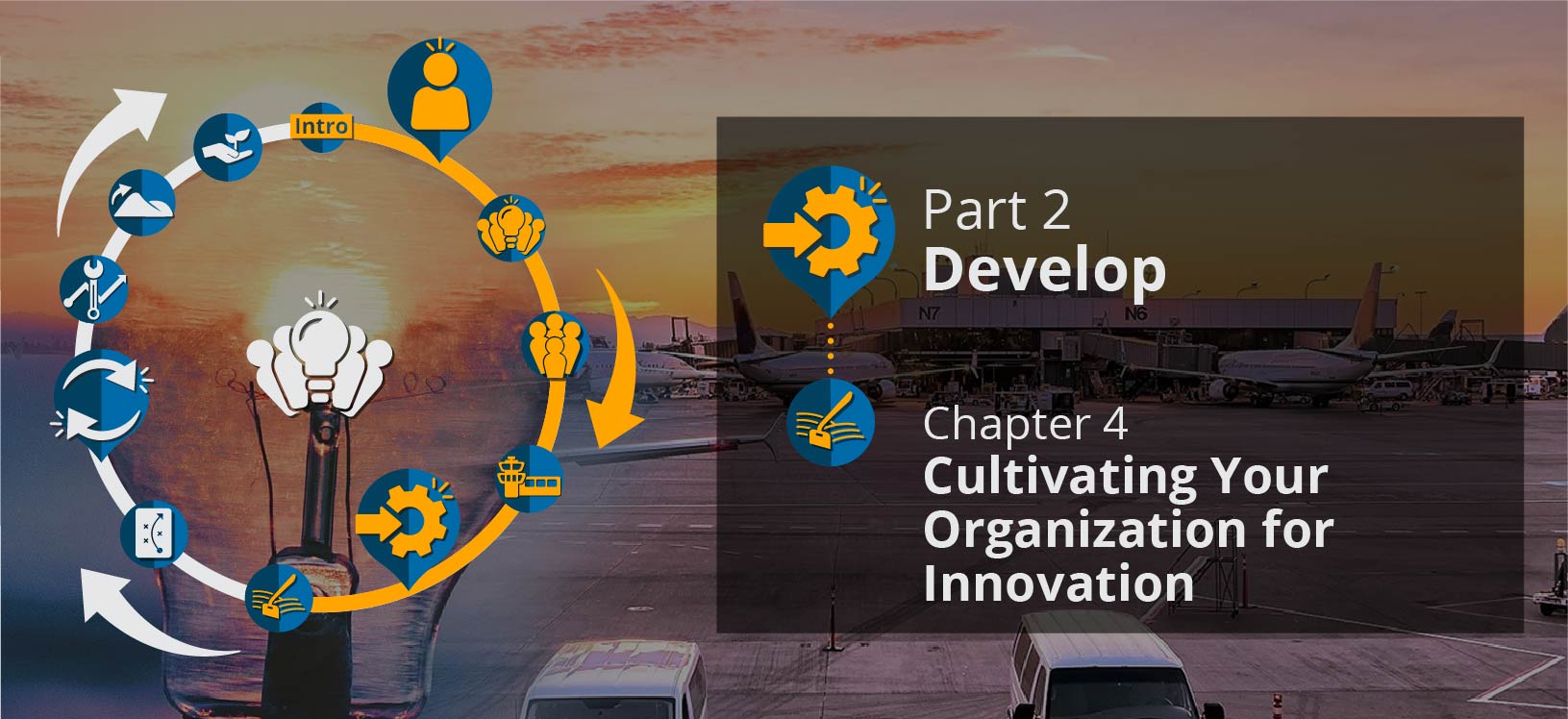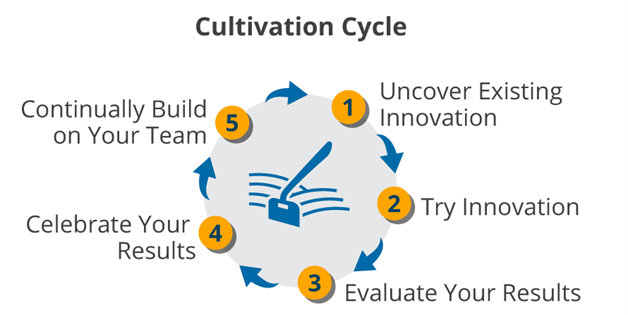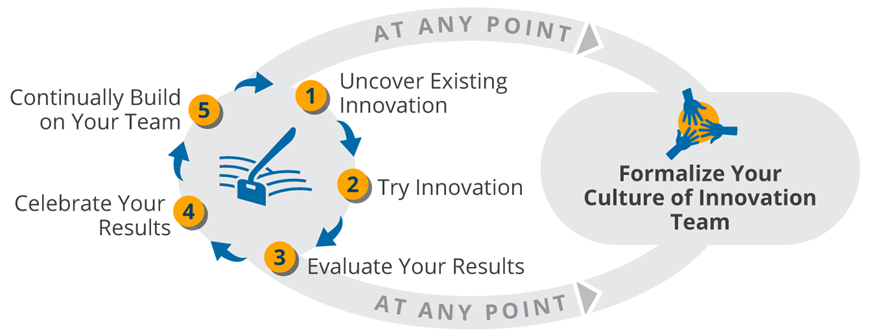
Chapter 4: Cultivating Your Organization for Innovation
There are several things you can do right now to start cultivating your organization to transition to a culture of innovation, as highlighted in Figure F4.1.

Figure F4.1: Cultivation Cycle.
This approach is valuable for the following reasons.
- Simple: It helps you capitalize on the innovation already occurring naturally and discover people with the drive and initiative to be innovative.
- Builds incrementally: It demonstrates how to unite groups of creative thinkers to achieve common goals or surmount challenges.
- Fast and inspirational: It shows how to use quick wins to showcase the power of an innovative culture to the rest of the organization.
Uncover Existing Innovation
Innovation most likely already exists in your organization or within your team. Go find it!
- Recognize progress you have already made and find out the “why” behind it.
- Identify your innovators (i.e., those involved in successes and strong drivers of improvement).
Try Innovation
Find examples that demonstrate why a culture of innovation is desirable.
- Identify a start-up innovation team.
- Assemble your start-up team to identify and prioritize your top challenges and needs through an established decision-making/escalation process and pick one or more challenges to solve. (See this Deep Dive page for more information and a definition of the escalation process.)
- Leverage existing working relationships and establish new relationships within, across, and outside the organization with partners to help solve the challenge.
- Ideate, solve, plan, and implement your solution using the teams and relationships you have put in place.
Evaluate the Results
Now that you have tried innovating, how did it go? Did you solve the challenges you set out to solve? If not, pinpoint the exact reasons.
- Review how well your ideas solved the challenge.
- Identify and track any issues arising from the solutions themselves.
- Take a step back and evaluate the process.
- After documenting lessons learned, think about new policies and procedures that can build on these new methods for overcoming challenges. Make innovation part of how your organization does business going forward!
Celebrate the Results
Once you have a new idea, share it with your organization. Highlight team members who worked hard to make success happen.
- Seek out all participants who contributed to a new idea.
- Determine how best to celebrate those participants. Start by asking others who work with them about what motivates them or is meaningful to them.
- Plan the celebration. Get all the details in place, including approvals and logistics.
- Celebrate! Make sure participants are recognized publicly for their efforts.
Continually Build on Your Culture of Innovation Team
If you started up an innovation team, evaluate how the team is doing. If the group has not changed in size or function since it was created, it may be time to help your team evolve by doing the following:
- Invite new people. Who has not participated yet?
- Invite a whole business unit.
- Invite those who are change resistant (i.e., inhibitor or destroyer personas) by enlisting their help with a challenge that needs to be solved.
- Find new challenges to solve (e.g., hold a competition to generate new ideas).
- Continue to look for opportunities to bring more people to the team. The bottom line is to keep inviting more people to the team so that everyone begins to incorporate innovation into not only the group but also their daily tasks.
Go through the cultivation cycle a few times, tackle a few challenges, and see who comes together regularly. This is the beginning of your formal culture of innovation team (as shown in Figure F4.2). Use this dedicated team to drive the culture change.

Figure F4.2: Cultivation Cycle Leading to a Culture of Innovation Team.
If you already have a formal innovation team, you can add a cultural element to this group. However, most innovation teams are (rightly) focused on implementing specific innovations. The point of the culture of innovation team is different, specifically focused on developing the culture. If your innovation team is not able to put the right focus on the culture, it may be ideal to have a distinct yet integrated team.
Be sure this team is not an exclusive, siloed group and has comprehensive participation and involvement, including
- Executive-level management, business function leaders, managers, and frontline staff;
- All generations, from baby boomers to Gen-Xers, millennials, and Gen-Zers; and
- A mix of genders, races, and various backgrounds.
Beyond inclusion: Your team must promote a culture of innovation for itself, which necessitates a sense of belonging and comradery. Further, don't exclude valuable team members because they do not “check” certain boxes. Focus on including feedback and input from the broadest range of perspectives.
And remember that, just like the start-up team, this formal team should constantly evolve. Always be looking to cycle people in and out of the group so that fresh perspectives and viewpoints are always present.
Identifying Barriers to a Culture of Innovation
If you have tried to form an innovation team, you might have already come across some challenges and barriers. Table F4.1 aligns several common barriers to the 25 plays that are presented in Chapter 5 as options you can select to start developing a culture of innovation. These are further categorized under the five organizational elements that can affect culture.
Table F4.1: Common Barriers and Plays to Solve Them.
| Leader-Related Barriers | Leader-Related Plays |
| Not attuned to innovation | Play 1: Prioritize Innovation |
| Micromanagement | Play 2: Empower Staff |
| Sticking to the status quo | Play 3: Drive Change |
| Lack funding | Play 4: Seek Affordable Solutions |
| Putting the employee first | Play 5: Put the Customer First |
| Staff-Related Barriers | Staff-Related Plays |
| Fear of failure | Play 6: Develop an Innovation Mindset |
| Fear of retribution | Play 7: Create a Safe Environment |
| Office politics | Play 8: Support Open Dialogue |
| Resisting change | Play 9: Focus on Behaviors that Support Change |
| Not communicating | Play 10: Improve Communications |
| Strategy and Policy-Related Barriers | Strategy and Policy-Related Plays |
| Lack a clear strategic plan | Play 11: Develop a Unifying Strategic Plan |
| Values do not support innovation | Play 12: Align with Organizational Values that Support Innovation |
| Focused on the short term | Play 13: Focus on the Long Term |
| Lack of unique & fresh ideas | Play 14: Prioritize an Exceptional, Comprehensive Team |
| Rigid HR hiring procedures
HR policies reward outcomes, not process |
Play 15: Drive Innovation into HR Policies and Practices |
| Organizational Structure-Related Barriers | Organizational Structure-Related Plays |
| Bureaucracy | Play 16: Aligning Organizational Structure to Support Innovation |
| Isolating innovation | Play 17: Effectively Roll Out Structural Changes |
| Inconsistent innovation acceptance | Play 18: Develop Strategies by Business Function to Overcome Resistance to Change |
| Not collaborating (low risk-tolerance) | Play 19: Create a Collaborative Work Environment |
| No budget for innovation | Play 20: Emphasizing Organizational Budgets to Support Innovation |
| Process and Procedure-Related Barriers | Process and Procedure-Related Plays |
| Lack of motivating goals | Play 21: Discover What Motivates Employees |
| Lack of time | Play 22: Structure Time for Speculation |
| Lack of training | Play 23: Provide Innovation-Related Learning Experiences |
| Working in silos | Play 24: Collaborate with Internal and External Partners |
| Lack of shared information | Play 25: Focus on Learning by Transferring Knowledge |
Do any of these strike a chord? If so, you now have a jump start into which plays in Chapter 5 you should consider first. If not, you can still use this handy matrix as a quick reference to align your plays in the future.
Before You Begin: A Word about Risk
Making any change-let alone a culture change-involves taking risks. Ways to alleviate risk include the following:
- Use a formal decision-making process during the “Try Innovation” step of the cultivation cycle.
- Define thresholds for escalating decision-making about new concepts upward for leadership approval.
- Be transparent about new ideas with coworkers and leaders, and collaborate with cross sections of colleagues to help prevent unacceptable risks from being taken.
- Keep ideas in line with your airport's strategic vision and policies. Make sure your ideas do not negatively impact your mission.
- Ensure compliance with local, state, and federal laws and rules.
- Align changes with the financial goals of your airport.
- Understand how changes may impact daily operations.
Evaluating the severity and impact of each risk for a new idea can be as simple as creating a risk map for relevant categories (e.g., strategy, compliance, financial, and operations for the last four examples above) and assigning a level of risk from 1 to 10 for each. Reviewing resources related to risk management, like continuity of operations plans or business continuity plans, can be a great way to understand potential risks and methods for mitigation.




